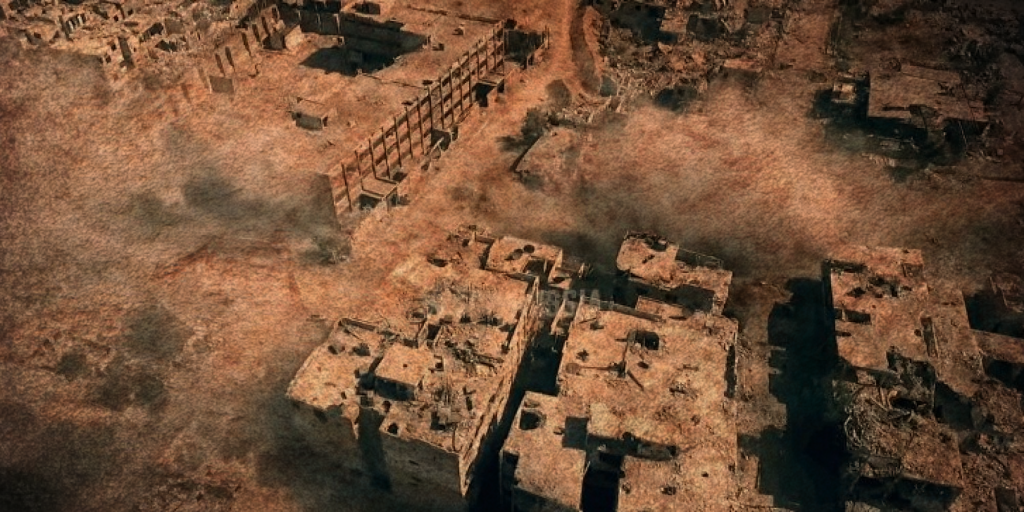
Written by Brian Betts exclusively for SouthFront
The typical examples of battle footage from the Syrian Arab Army (SAA) and embedded journalists feature urban environments. This is largely due to the fact that government forces continue to be the primary influence in larger city centers, such as Damascus and Homs . However, on the vast expanses of the Syrian Desert, rebel strongholds built atop isolated settlements continue to pose a grave challenge. There are two issues working against the SAA forces. The first issue pertains to the degradation of force strength, while the second is a lack of cover.
The Issue of Strength
Five years of war have taken their toll on the SAA. By 2013, Syrian government forces had already lost a quarter of their military equipment. Nearly 1800 tanks and armored fighting vehicles (AFVs) along with trucks and artillery were lost due to destruction or capture . Between Western coalition-backed weapon deliveries and the amplified wear-and-tear on machinery as time progressed, it is now estimated that attrition has claimed over half the SAA’s original strength. As a result, the availability of tanks and AFVs is an ever growing hurdle for SAA commanders to overcome. It is not uncommon to see SAA infantry assaulting rebel-held settlements with only a handful of vehicles to support.
The SAA’s order of battle has been heavily segmented and spread out. Combat divisions (furaq) are assigned to single districts (manatiq) within a greater governorate. Beyond serving as a staging area for operations, division headquarters (quiada al-firqa) serve as an all-in-one solution for training, engineering, supply storage, and housing .
Western media claims that the geographically wide distribution of the SAA is a preventative measure against a coup d’etat have a tenuous relationship with the truth. The availability of modern communication technology within the ranks of the military would conquer the physical distances between divisions if they desired to collude against their own government. The immediate reason for the widespread and isolated nature of the SAA’s order of battle has more to do with the availability of supply routes through foreign borders and the sheer number of concurrent fronts. With nearly 24 different criminal gangs operating across at least as many fronts, the SAA combat divisions have been set up to handle a situation that would give any centralized chain of command attention deficit disorder (ADD). The commanders that are best suited to assess the feasibility of an assault have been recognized as the division-level leaders who know their local environment well.
SAA divisions have overcome the shortage of support vehicles by heavily improvising. Technicals, or civilian vehicles with mounted weapons, are being constructed on a regular basis by all factions. In the more recent months of combat, SAA units have been showing an increasing capability to execute assaults with guerilla style tactics. The shortfall of armor and artillery is heavily subsidized with the addition of technicals armed with machine guns and anti-aircraft guns, such as the twin-barrel 23mm ZU-23-2. The government has partnered with local militias to help retake the land they’ve been displaced from when troop size had to be supplemented.
The Issue of Cover
In combat, cover is the premium towards which forward advances can be made. In addition to blocking incoming fire from the front, defilade or the broken line-of-site between the enemy and friendly flanks, is critical for preventing casualties. The Syrian Desert offers little in terms of geographic features beyond hills and scattered rocks. Isolated settlements built in desert regions can offer excellent visibility on the surrounding countryside, while offering very little cover for any attacking force. In the following two operations in the deserts outside Damascus and Deir ez-Zor, respectively, the “bounding overwatch” tactics of the SAA will be analyzed.
The SAA advances on ISIS near Damascus:
The SAA advances on ISIS near Deir Ez-Zor:
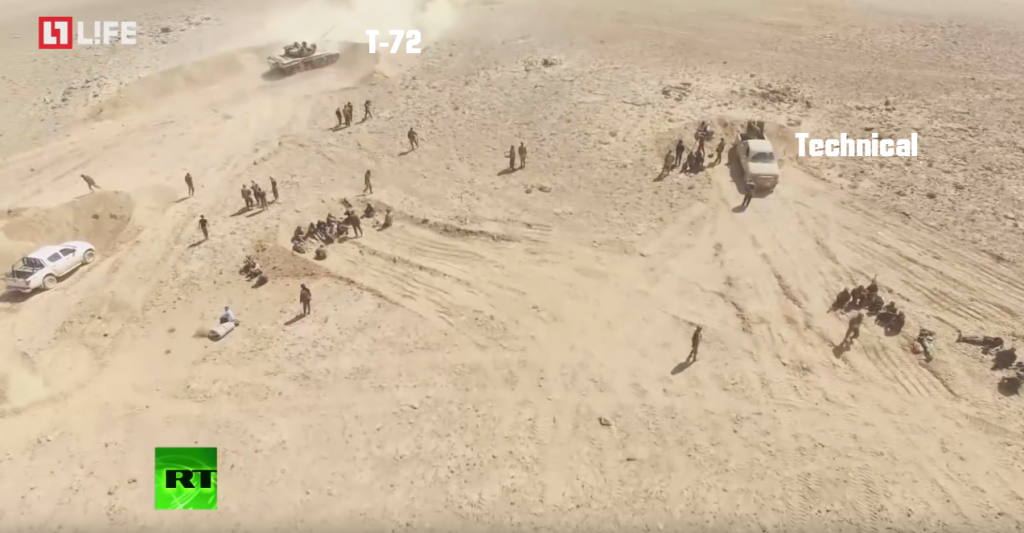
A staging area for an assault in the Syrian Desert, near Damascus, seen from a LIFE TV drone in the picture above. Approximately 2000 meters from the T-72 tank’s facing, a small settlement stands infested with ISIS. To some degree, the SAA has supplemented natural cover with prepared positions; mounds of dirt hastily created at the hands of a brave operator within an armored bulldozer. These positions represent more than a staging area for the assault, but the first position in a string of successive leaps where two or more SAA assault elements make successive advances on an isolated settlement.
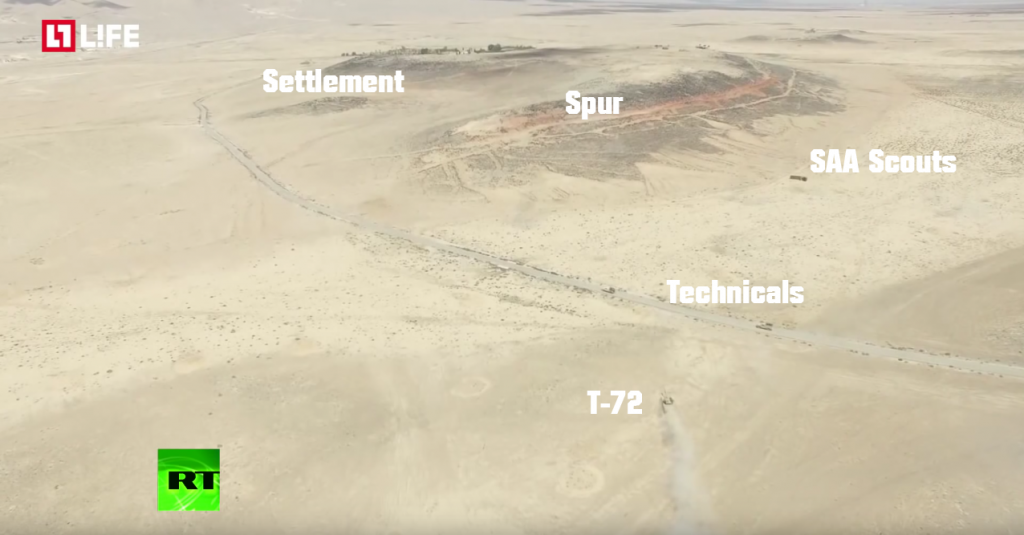
Where cover can’t be found, speed must be maintained. In this example, a T-72 and pair of technicals sprint across open ground towards a craggy spur. Not far beyond, the settlement and final objective. To the immediate front of the spur, a small roadside barrier hosts a few SAA scouts coordinating with the assaulting forces. The two technicals on the road are filled with troops ready to secure a position atop the spur.
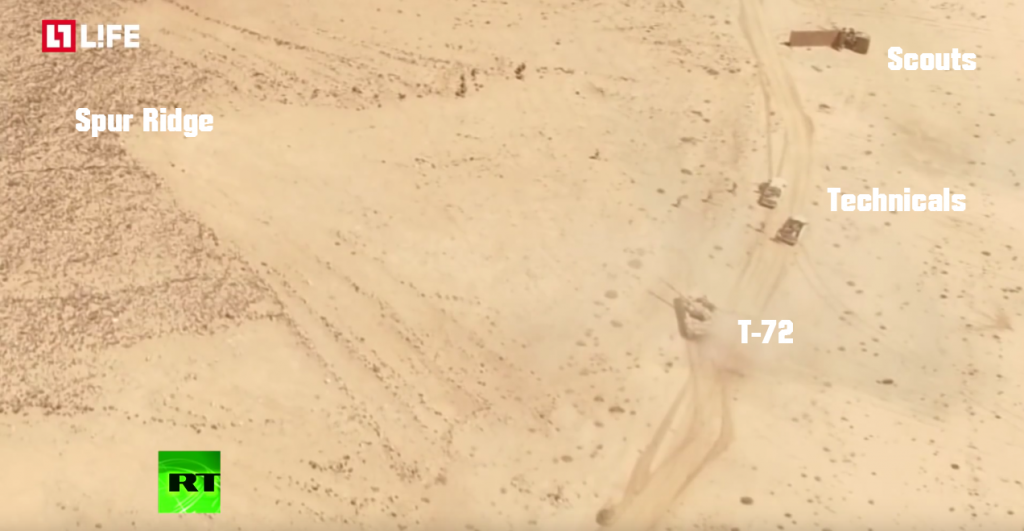
The roadside barrier and scouts can be seen in the upper portion of the image above. The two technicals are disembarking troops for the spur’s ridge. The T-72 provides overwatch for the assaulting troops.
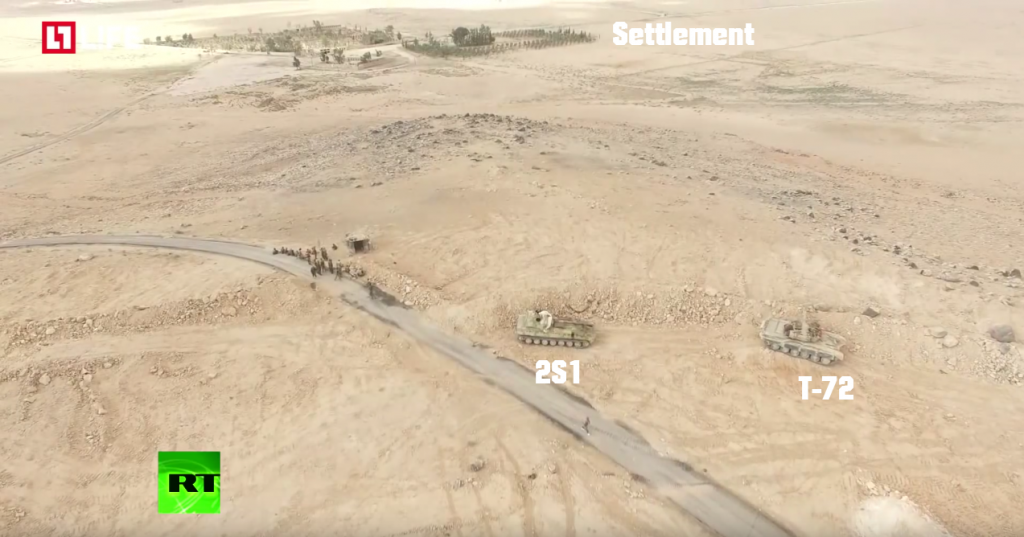
The troops take the ridge atop the spur and gain a commanding view of the settlement. Once the position is secure, a single 2S1 Gvozdika self-propelled howitzer joins the T-72 to lay down a barrage of high explosive (HE) on the settlement. It is important to note that the settlement is devoid of all life forms save for jihadists. ISIS executed all 280 civilians inhabiting the settlement, creating one of many ‘ghost towns’ dotting the Syrian Desert.
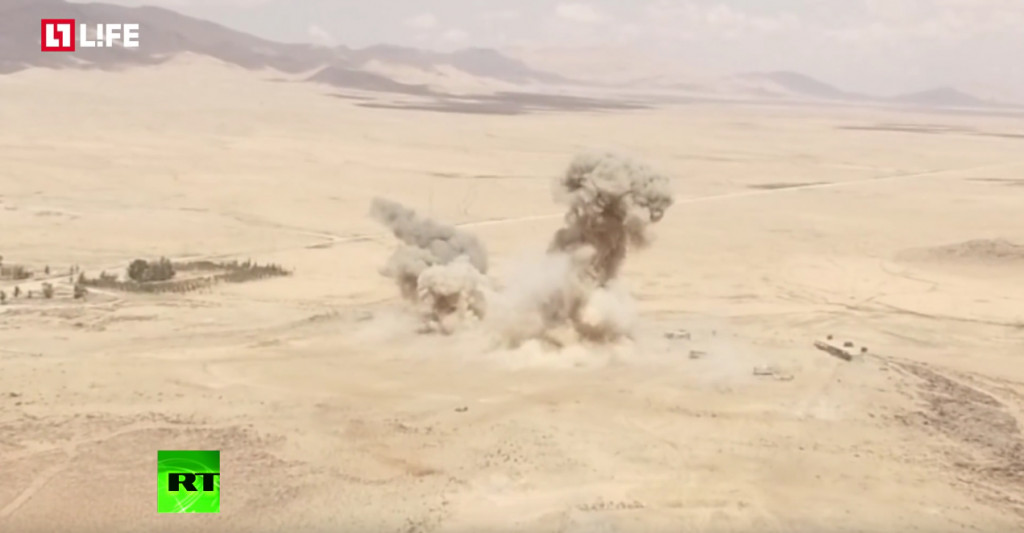
The T-72 and 2S1 deliver accurate fire against ISIS positions outside the settlement. In short order, all jihadist forces withdraw to the relative safety of the settlement buildings. With this action, the second phase of the settlement assault begins with infantry following the preceding artillery barrage.
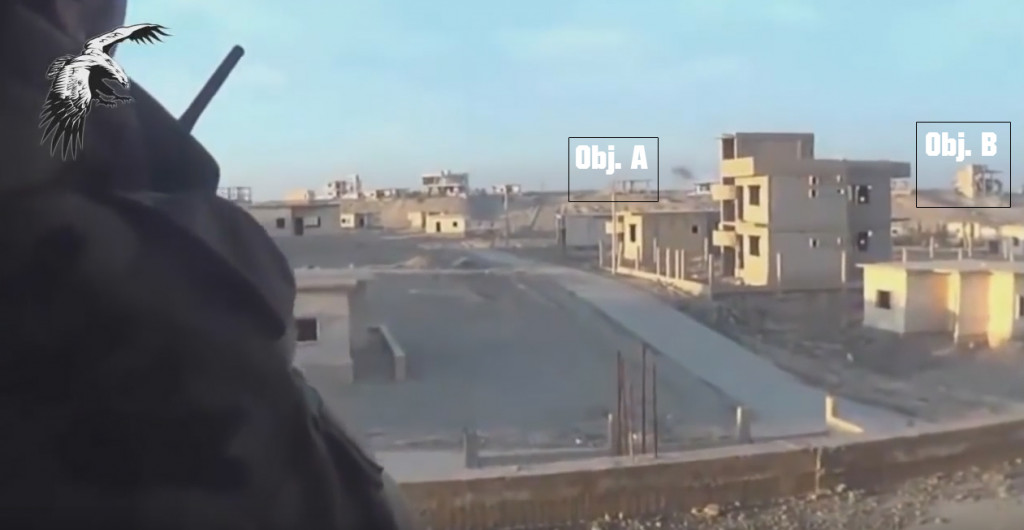
Unfortunately, there is no further footage of the final assault on the settlement itself from the previous example. However, there is SAA footage of a final assault on a similar settlement outside of Deir ez-Zor that has already been staged by the government forces. In the following case, we see SAA forces make their final assault on ISIS positions inside another ‘ghost’ settlement. In the image above, just over the commander’s silhouetted shoulder, Objective A houses jihadists armed with assault rifles and grenades. Objective B is further off to the right, and appears to have prepared positions dug on either side of the building.
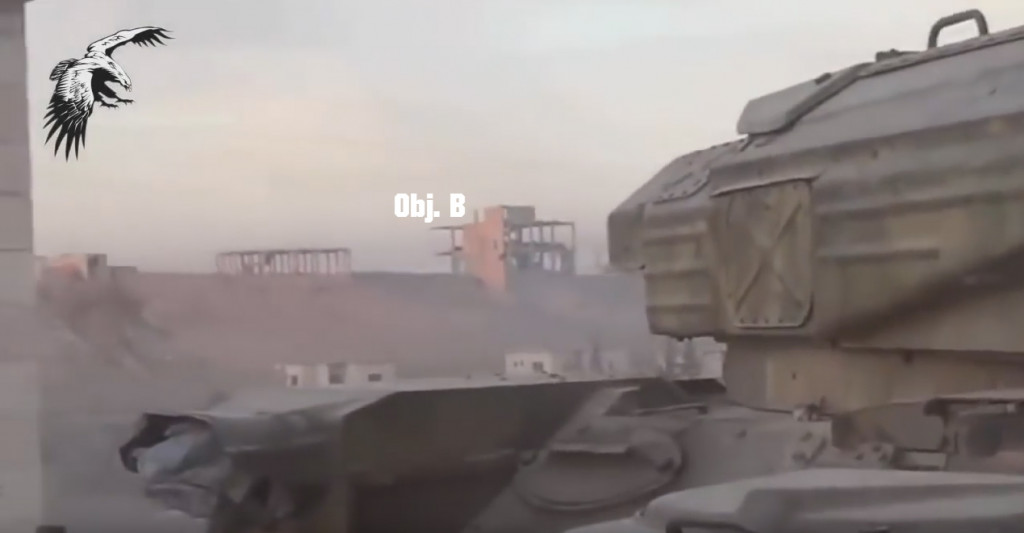
Where artillery isn’t available, the SAA is forced to improvise. Instead of suppressing the ISIS criminals with artillery fire, the SAA rake their positions with a ZSU-23-4 Shilka. The quadruple 23mm anti-aircraft guns fire snarling bursts of explosive shells, shredding the Objective B building where ISIS fighters hide.
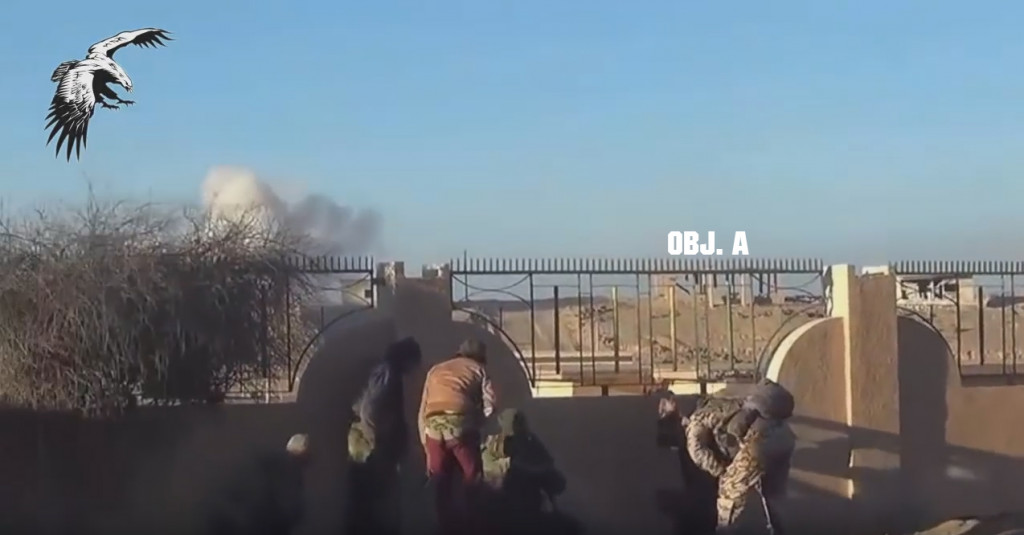
SAA troops get in position to assault Objective A, which is visible just beyond the fence on the hill. A cloud of dust from a 125mm HE round can be seen in the left portion of the screen grab.
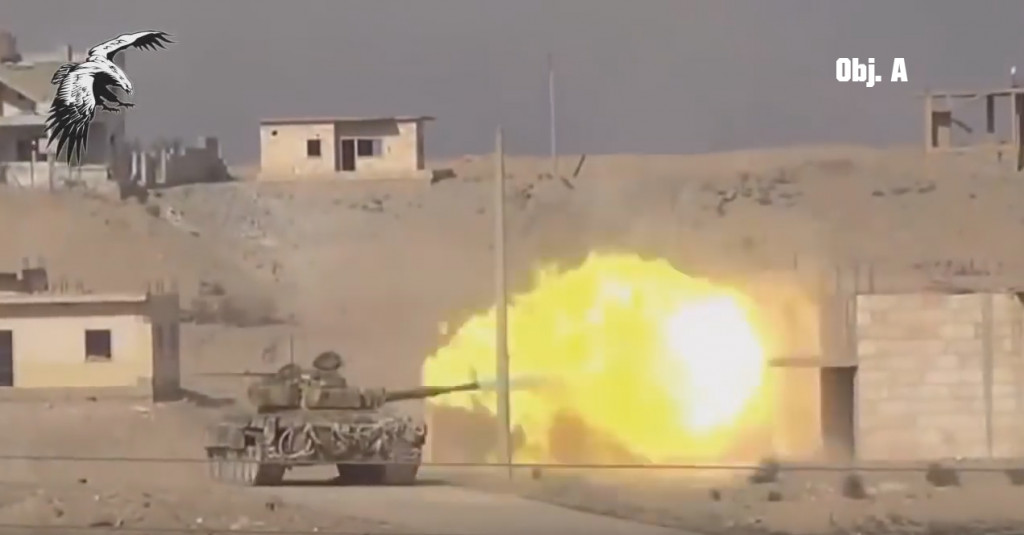
With Objective A in the background, a T-72 in the foreground belches fire as it delivers HE rounds to Objective B. After completing its rounds, the T-72 withdraws and the infantry begin their assault against a wounded and dazed enemy.
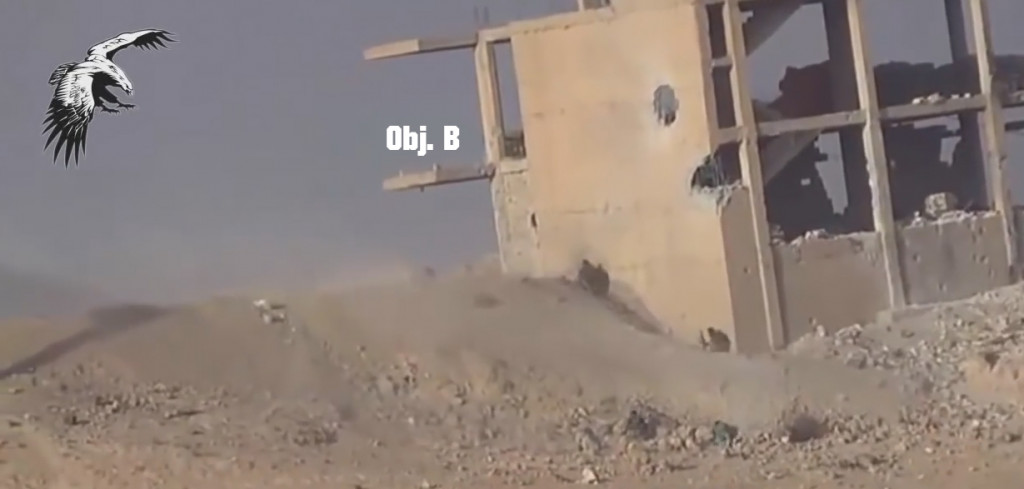
Objective B is seen pulverized by 125 mm HE and 23 mm Shilka rounds. SAA soldiers hug the walls of the building as they hurl grenades into the ISIS trenches. When a break in enemy fire is heard, the soldiers take turns firing over the threshold of the trench.
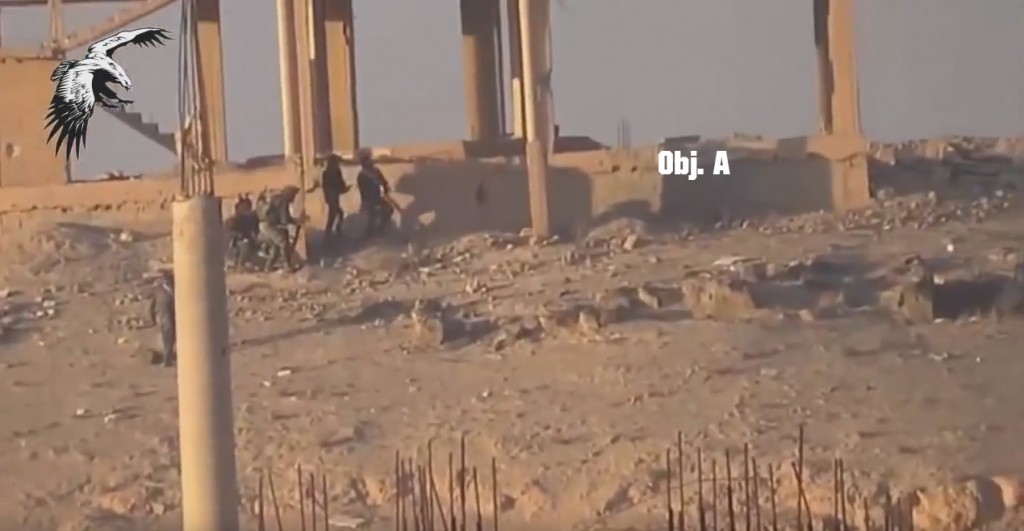
Syrian troops at Objective A provide flanking fire against ISIS positions, supporting their comrades at Objective B. Soon after, troops are seen standing triumphant on the hill waving the Syrian flag in a howling wind.
Qualitative Gains
Although the Syrian army has suffered quantitative losses in the defense of their country, officers in the rank-and-file describe a qualitative increase in their remaining strength. While equipment can be repaired and replaced, loyalty in the frontline fighters of the SAA cannot. Russian assistance in terms of T-72B and T-90S tanks, as well as air strikes have helped bolster SAA efforts in the conflict zone. However, in terms of manpower, the Syrian government continues to rely on a much smaller force of battle-hardened and loyal fighters. The SAA infantry man that remains in 2016 is an entirely different breed than his counterpart in 2011, at the outbreak of war. The tactics described above depict a fighting force that is no stranger to close contact, and capable of employing mobile, guerrilla-style tactics against criminal gangs.
Sources
- http://www.dw.com/en/the-many-fronts-in-syrias-civil-war/a-16868658
- https://warisboring.com/how-to-take-out-1-800-tanks-in-two-years-74ecd413cb93#.w6dogmxci
- http://carnegie-mec.org/2016/03/10/strength-in-weakness-syrian-army-s-accidental-resilience/iuz7
- http://www.dailystar.com.lb/News/Middle-East/2014/Oct-22/274895-syria-army-adapts-to-guerrilla-war.ashx#axzz3GNapFJpb
- https://www.youtube.com/watch?v=LDT0vAqbaKA
- https://www.youtube.com/watch?v=1q4sw5wkf90






Lovely piece.
Well written